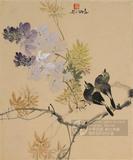清惲壽平寫生花卉 冊 洛浦仙裳
推薦分享
資源連結
連結到原始資料 (您即將開啟新視窗離開本站)後設資料
- 資料識別:
- 故畫001198N000000009
- 資料類型:
- 類型:繪畫
- 型式:靜態圖像
- 著作者:
- 惲壽平
- 主題與關鍵字:
- 蓮荷
- 出版者:
- 數位化執行單位:國立故宮博物院
- 格式:
- 本幅 26.3x33.4公分、全幅 64.6x42公分
- 關聯:
- 故宮書畫錄(卷六),第四冊,頁135-137&*故宮書畫圖錄,第二十四冊,頁138-141&*惲壽平(1633-1690),原名格,字壽平,後以字行,江蘇武進人。初善作山水,因自謙無力與王翬(1632-1717)爭勝,遂改工花卉。畫法承自徐崇嗣(10世紀後半)之沒骨法,又參以己意,風格獨創,蔚為清代花卉畫宗師。 本幅選自〈寫生花卉冊〉,畫一朵白荷在蓮葉掩映間,初綻芳華。落墨清雅脫俗,極得蓮荷出淤泥而不染的逸趣。「洛浦」一詞,意指傳說中洛水之濱的女神-洛神,畫題作「洛浦仙裳」,應有借花擬人的寓意。荷花,又名水芙蓉,畫家自稱是「芙蓉溪叟」,足見其愛物之深。(20110102)&* Yun Shouping originally had the name Ge and the style name Shouping, by which he later went. A native of Wujin in Jiangsu, he at first excelled at landscape painting but later felt that he could not compete with the master Wang Hui (1632-1717), turning to flowers instead. His style derives from the “boneless” method of washes used by Xu Chongsi (fl. latter half of 10th c.), but with his own interpretation as well. With his tender and elegantly beautiful manner, Yun Shouping became a master of flower painting in the Qing dynasty praised by many. This leaf comes from “Album of Flowers Sketched from Life” and depicts a white lotus about to blossom in full splendor and set off between lotus leaves. The use of ink is elegant and untrammeled, successfully portraying the ability of the lotus to emerge from muddy waters untainted. “Luo Banks” refers to the shores of the Luo River, where the legendary Goddess of the Luo River was said to reside. Thus, the title of this work uses the blossom to personify this deity. The lotus, also known in Chinese as “water hibiscus,” is likewise mentioned by the artist in his inscription as “Elder of the Hibiscus River,” demonstrating an appreciation for this blossom.(20110102)&*1.〈清 惲壽平 洛浦仙裳〉,收入譚怡令、劉芳如、林莉娜主編,《滿庭芳 歷代花卉名品特展》(臺北:國立故宮博物院,2010年十二月初版一刷),頁120。
- 管理權:
- 國立故宮博物院
授權聯絡窗口
- 國立故宮博物院圖像授權、出版授權、影音資料授權-申請流程說明
http://www.npm.gov.tw/zh-TW/Article.aspx?sNo=03003061






